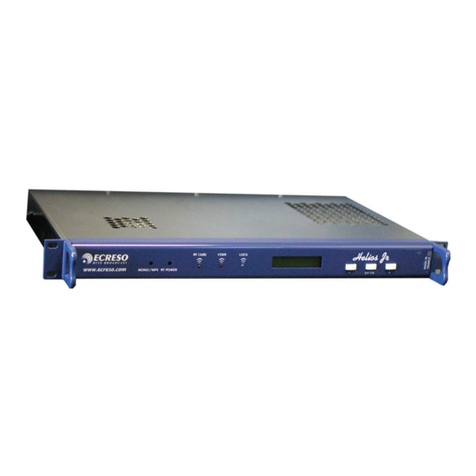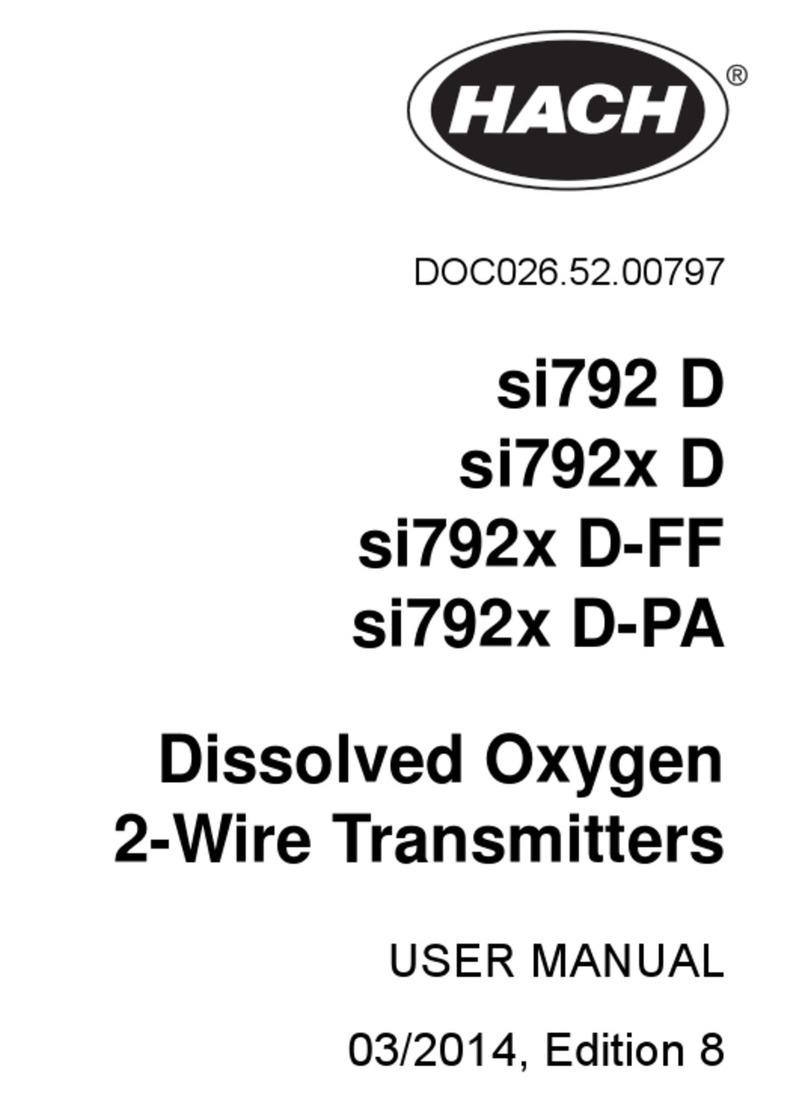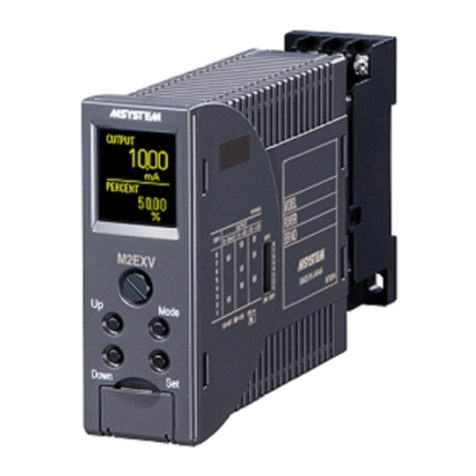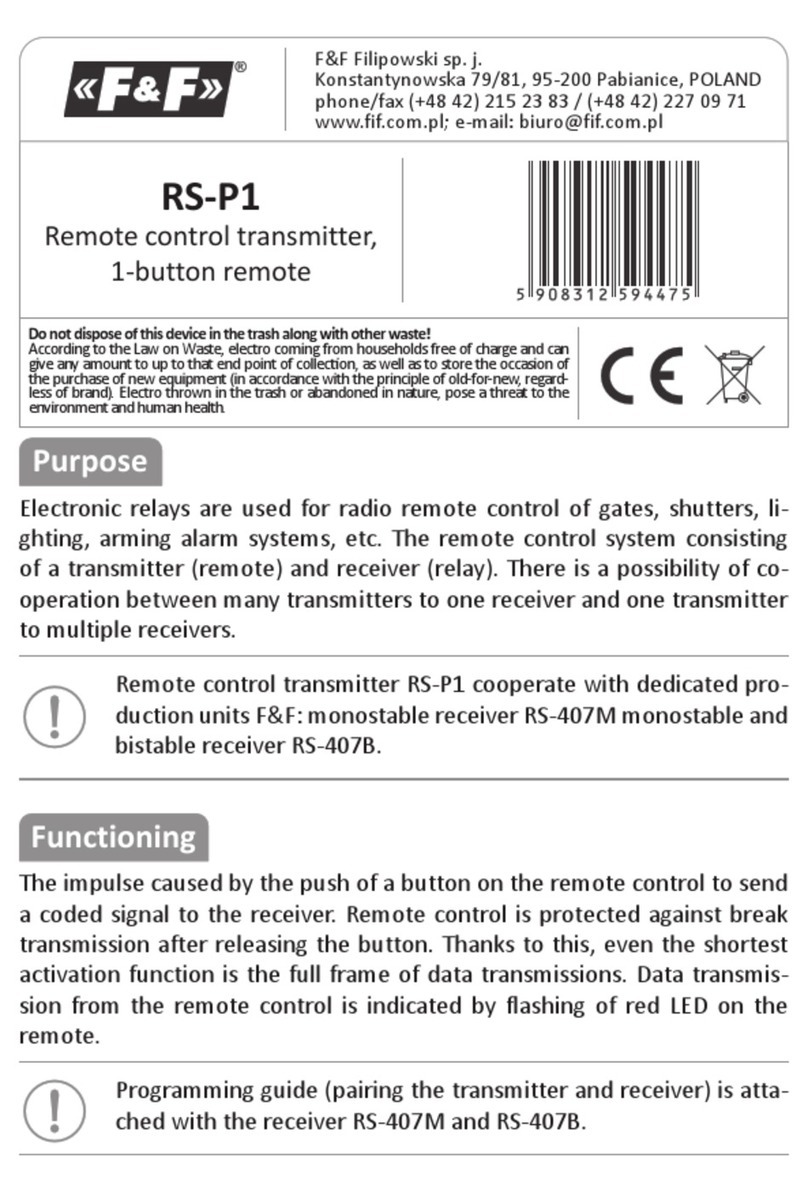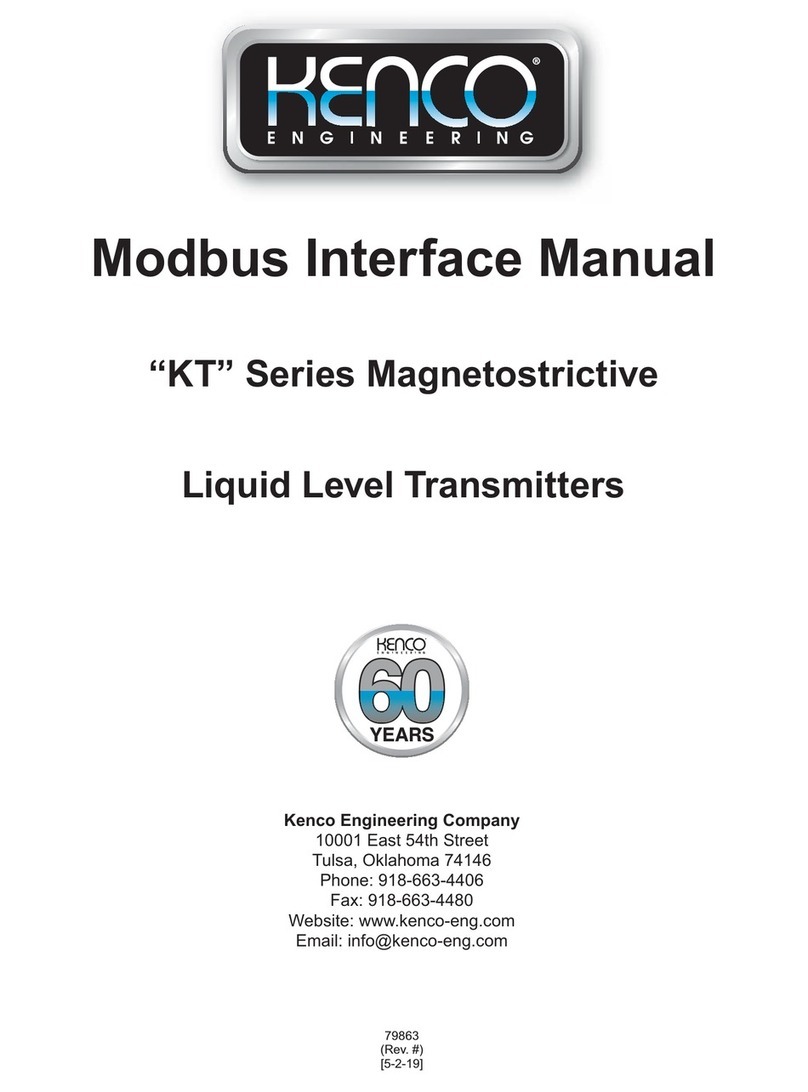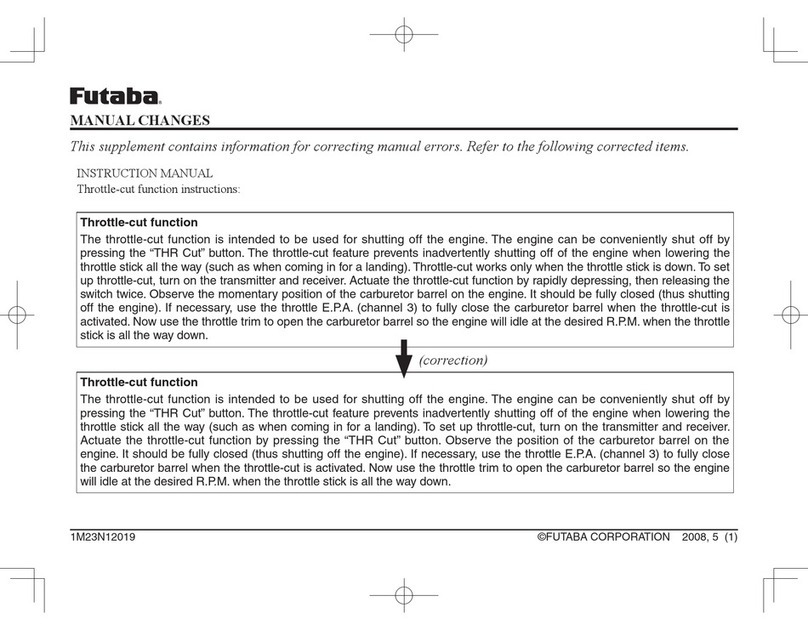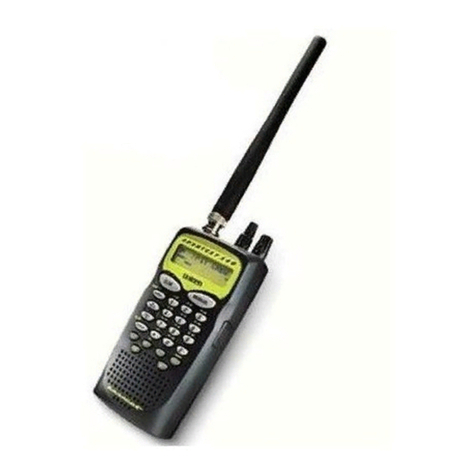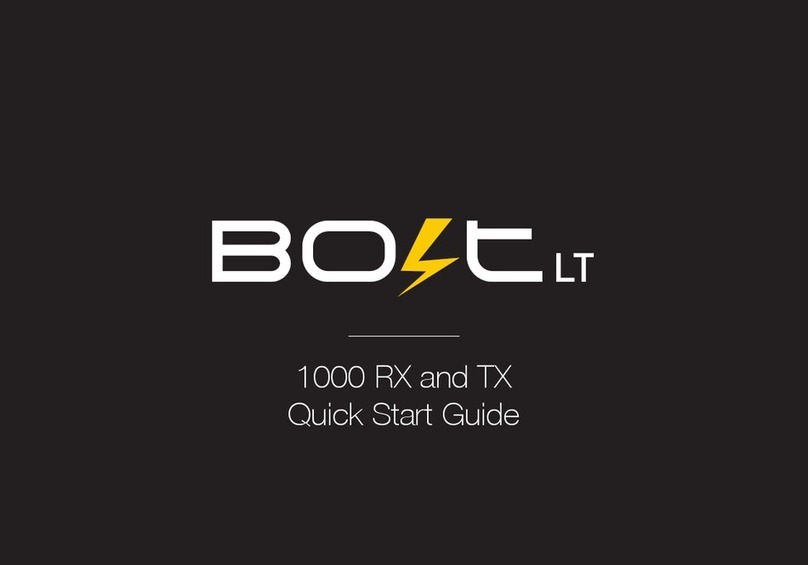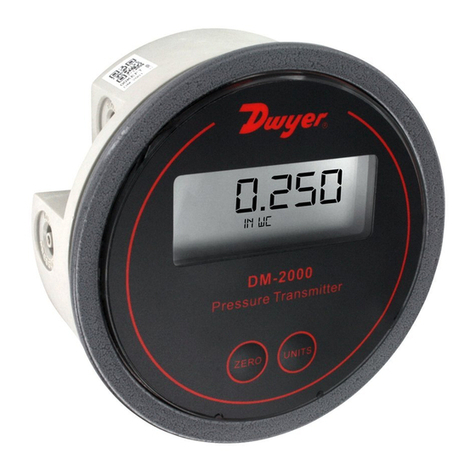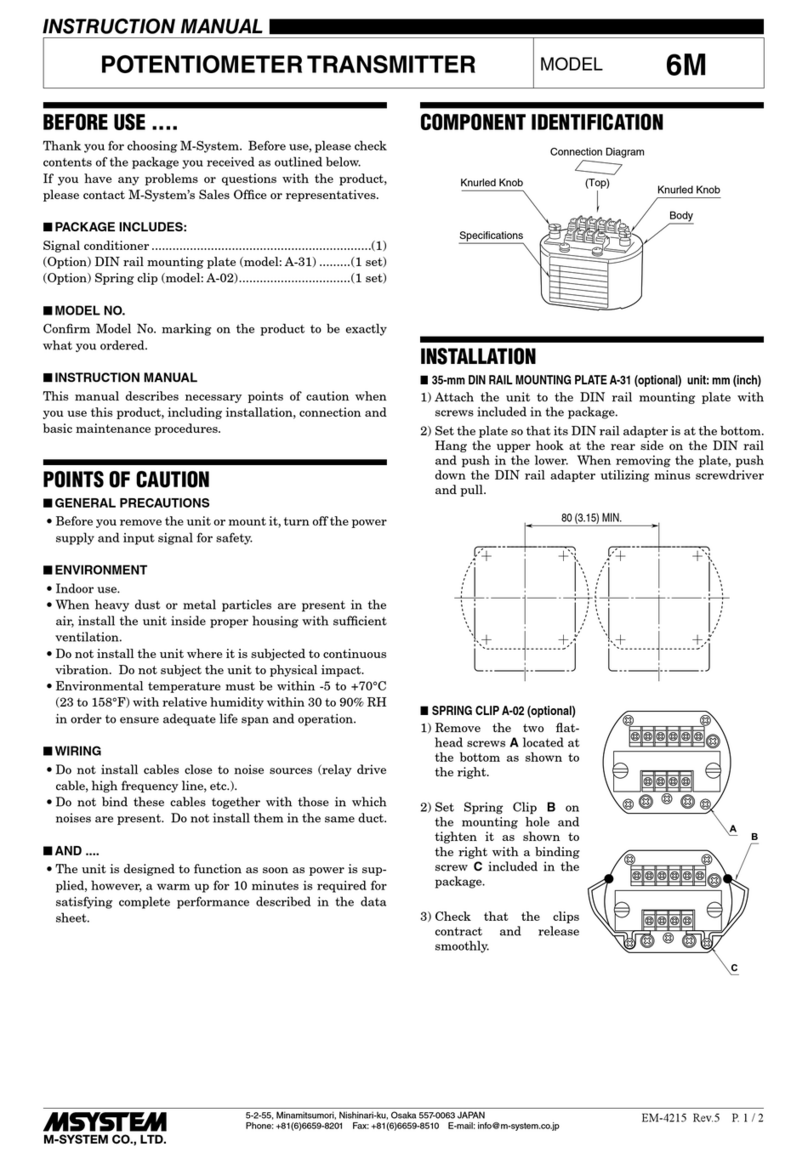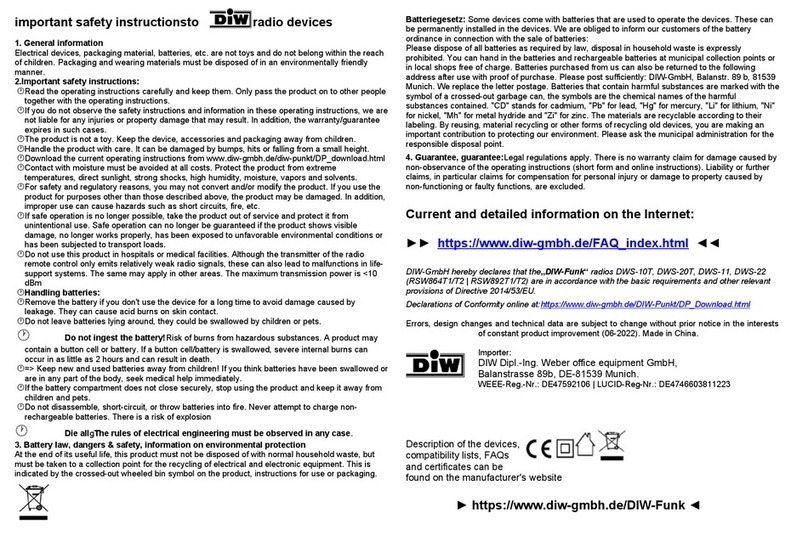Ecreso Helios FM 20/100 W User manual

ecreso WorldCast Systems Group
web: www.ecreso.com - e-mail: contact@ecreso.com
Helios FM 20/100 W
User manual
87.5 – 108 MHz
20 OR 100 W STEREO AND MULTIPLEX COMPACT FM DIGITAL
TRANSMITTER
WITH TCP/IP MONITORING*
*depending on options
Date: 2011/12/05

Helios FM 20/100 W, user manual– 12/2011
Page 2
Head Office : Parc d’activites Kennedy - 20, avenue Neil Armstrong – F-33700 Bordeaux-Merignac (France)
TABLE OF CONTENTS
1. INTRODUCTION ................................................................................................................................. 4
1.1.About Ecreso.............................................................................................................................. 4
1.2.Before you start .......................................................................................................................... 5
2. DESCRIPTION .................................................................................................................................... 6
2.1.General description .................................................................................................................... 6
2.2.Helios FM 20/100 W Description................................................................................................ 7
2.2.1.Front panel ............................................................................................................................ 7
2.2.2.Rear panel............................................................................................................................. 8
2.2.3.Opened cover........................................................................................................................ 9
2.2.4.Synoptic............................................................................................................................... 10
2.2.5.2U Rack............................................................................................................................... 11
3. TECHNICAL SPECIFICATIONS....................................................................................................... 12
3.1.RF section ................................................................................................................................ 12
3.2.Composite operation ................................................................................................................ 12
3.3.Stereo operation....................................................................................................................... 12
3.4.Mono operation ........................................................................................................................ 12
3.5.AF inputs .................................................................................................................................. 13
3.6.HF output.................................................................................................................................. 13
3.7.Power supply............................................................................................................................ 13
3.8.Interface panel.......................................................................................................................... 14
3.9.Environmental .......................................................................................................................... 14
3.10.Physical .................................................................................................................................... 14
3.11.Miscellaneous........................................................................................................................... 14
4. STARTING UP YOUR TRANSMITTER............................................................................................ 15
4.1.Connecting the transmitter ....................................................................................................... 15
4.2.Setting the transmitter .............................................................................................................. 16
4.3.Input selection .......................................................................................................................... 17
4.4.Setting the MPX inputs............................................................................................................. 17
4.5.MPX configuration .................................................................................................................... 17
4.6.Setting the analog or AES inputs ............................................................................................. 17
4.7.Getting on air............................................................................................................................ 17
5. FRONT SCREEN USE...................................................................................................................... 18
5.1.Overview................................................................................................................................... 18
5.2.Working principe....................................................................................................................... 18
5.3.Structure of the menus............................................................................................................. 20
5.3.1.First level measurements.................................................................................................... 20
5.3.2.First level menus ................................................................................................................. 21
5.3.3.TX PARAMETERS Menu.................................................................................................... 22
5.3.4.ALARMS Menu.................................................................................................................... 22
5.3.5.INPUT SELECT Menu ........................................................................................................ 23
5.3.6.INPUT SWITCH Menu ........................................................................................................ 24
5.3.7.LINE1 Menu ........................................................................................................................ 25
5.3.8.MPX in Menu....................................................................................................................... 26
5.3.9.Audio Gene Menu ............................................................................................................... 27
5.3.10.Modulation Menu................................................................................................................. 28
5.3.11.Stereo encoder Menu.......................................................................................................... 29
5.3.12.RDS Menu........................................................................................................................... 30
5.3.13.Network Menu ..................................................................................................................... 31

Helios FM 20/100 W, user manual– 12/2011
Page 3
Head Office : Parc d’activites Kennedy - 20, avenue Neil Armstrong – F-33700 Bordeaux-Merignac (France)
5.3.14.COM Menu.......................................................................................................................... 32
5.3.15.Power supply Menu............................................................................................................. 33
5.3.16.Temp/Fan Menu.................................................................................................................. 34
5.3.17.Time/Date Menu.................................................................................................................. 35
5.3.18.About Menu......................................................................................................................... 36
5.3.19.Exit Menu ............................................................................................................................ 37
5.4.Parameters description ............................................................................................................ 38
5.4.1.INPUT SELECT Menu ........................................................................................................ 38
5.4.2.INPUT SWITCH Menu ........................................................................................................ 38
5.4.3.Menu LINE 1 (ANA) ............................................................................................................ 39
5.4.4.LINE 2 Menu (AES)............................................................................................................. 40
5.4.5.MPX IN Menu...................................................................................................................... 40
5.4.6.AUDIO GENE Menu............................................................................................................ 41
5.4.7.MODULATION Menu .......................................................................................................... 42
5.4.8.STEREO ENCODER Menu ................................................................................................ 43
5.4.9.RDS Menu........................................................................................................................... 44
6. SERIAL COMMANDS ....................................................................................................................... 48
6.1.Working principle...................................................................................................................... 48
6.2.Serial commands.............................................................................. Erreur ! Signet non défini.
6.2.1.System commands...................................................................... Erreur ! Signet non défini.
6.2.2.Measurement commands............................................................Erreur ! Signet non défini.
6.2.3.Configuration commands ............................................................Erreur ! Signet non défini.
6.2.4.Alarm commands ........................................................................Erreur ! Signet non défini.
6.2.5.Input commands..........................................................................Erreur ! Signet non défini.
6.2.6.Encoder commands ....................................................................Erreur ! Signet non défini.
6.2.7.RDS commands .......................................................................... Erreur ! Signet non défini.
6.2.8.Transmitter commands ............................................................... Erreur ! Signet non défini.
6.2.9.Status commands .......................................................................Erreur ! Signet non défini.
6.2.10.Communication board commands .............................................. Erreur ! Signet non défini.
6.3.HyperTerminal connection ....................................................................................................... 49
7. REMOTE CONTROL AND MONITORING WITH THE GPIO BOARD ............................................ 60
7.1.Introduction............................................................................................................................... 60
7.2.Description of control and monitoring functions ....................................................................... 60
7.3.Remote control function pinout ................................................................................................ 60
7.4.Remote monitoring function pinout .......................................................................................... 61
7.5.Physical representation of the GPIOs...................................................................................... 62
7.6.Management using the optional TCP/IP board ........................................................................ 63
8. THE EMBEDDED WEBSITE ............................................................................................................ 65
8.1.Introduction............................................................................................................................... 65
8.2.Connecting to the embedded web site..................................................................................... 65
8.3.Viewing the Status.................................................................................................................... 66
ANNEXE A : .......................................................................................................................................... 79
FOR MORE INFORMATION................................................................................................................. 80

Helios FM 20/100 W, user manual– 12/2011
Page 4
Head Office : Parc d’activites Kennedy - 20, avenue Neil Armstrong – F-33700 Bordeaux-Merignac (France)
1. INTRODUCTION
1.1. About Ecreso
Founded in 1956 near Bordeaux, ECRESO was created by radio broadcasting enthusiasts and counts today
as one of the most important players on the international broadcasting stage.
ECRESO offers analog and digital radio as well as digital TV transmitters (FM, DAB, DAB+, T-DMB, DVB-
T/H), low power transmitters, which are air-cooled, as well as high power devices either air or water-cooled.
ECRESO is part of the WorldCast Systems group of companies which combines the collective expertise &
extensive product portfolio of several major broadcast brands to offer turnkey systems in all major analog
and digital technologies. Other brands within the group include:
•Audemat who designs monitoring equipment for analog and digital radio and TV as well as an
extensive range of facility remote control solutions.
•APT Codecs who offer reliable and cost effective broadcast codec platforms delivering high quality
content over IP, T1, E1, ISDN & Leased Lines.
As such, WorldCast Systems can offer complete broadcast solutions for the delivery, transmission and
monitoring of broadcast content throughout the broadcast chain.
The group is founded on three core values:
1) Product innovation:
Audemat places a key emphasis on Research & Development and its innovative approach has been
repeatedly recognized by the industry. WorldCast Systems has won awards for innovation at
consecutive NAB Shows for over 10 years.
2) Customer satisfaction:
Audemat is dedicated to ensuring the best quality, value and service for its customers and has
achieved IS0 9001 certification.
3) Sustainable Development:
Audemat is committed to sustainable development and demonstrates this commitment in several
ways: it has been ISO 14001 certified since 2007, adheres to the UN Global Compact project and all
new products are developed in keeping with an eco-design philosophy and built within Audemat’s
low energy consumption factory.
Audemat/Ecreso employs around 80 employees at headquarters in Bordeaux-Merignac, France.
Audemat/Ecreso also has a subsidiary in Miami, USA that manages the North & South American markets as
well as sales offices in the UK, India and China. An extensive network of international dealers and
distributors means that the company is represented in over 45 countries throughout Europe, Middle East,
Africa and Asia.

Helios FM 20/100 W, user manual– 12/2011
Page 5
Head Office : Parc d’activites Kennedy - 20, avenue Neil Armstrong – F-33700 Bordeaux-Merignac (France)
1.2. Before you start
This equipment complies with international mechanical and electrical standards. To maintain this
compliance, as well as to ensure proper and safe working conditions and avoid electrical shocks and fire
hazards, you must comply with the following recommendations:
1 - The device should only be utilized in the conditions described in the user manual.
2 - The device is designed for industrial usage and must only be operated by qualified personnel.
3 - The device may be heavy; it must be lifted and handled with care, specifically during unpacking and
set up.
Electrical precautions
4 - Unplug from mains outlet before any intervention.
5 - Any maintenance, adjustment or repair must be carried out by personnel specifically trained by
WorldCast Systems.
6 - Before switching on the device, make sure the nominal voltage specified on the device matches the
mains nominal voltage.
7 - The device should only be operated on a stable electrical network. If the electrical network is not
stable, a power conditioner, such as a UPS, must be used
8 - The device must only be used with a plug that incorporates a protective ground contact.
9 - To avoid any risk of electrocution, the protection conductor must not be cut, intentionally or
accidentally, either on the device or on the power cord.
10 - High quality shielded cables are mandatory.
Environmental precautions
11 - It is necessary to verify that environmental conditions comply with those recommended in the
manual.
12 - Nothing must obstruct the ventilation.
13 - To avoid any electromagnetic interference, the device must only be used when it is closed, installed
in a cabinet and connected to the earth as per the instructions.
14 - The device should not be exposed to dripping or splashing and no objects filled with liquids, such as
coffee cups, should be placed on the equipment.
Precautions regarding the lithium battery
This device includes a lithium battery.
If the battery is not correctly replaced, there is a risk of explosion.
Only replace it with a battery of the same type. Contact us before attempting to use another type
15 - Do not puncture the battery
16 - Do not throw the battery in fire
17 - Do not immerse the battery in water
18 - Do not throw away the used battery, recycle it instead. You may send it back to us if needed.
If these precautions are not followed, the guarantee will be void.

Helios FM 20/100 W, user manual– 12/2011
2. DESCRIPTION
2.1. General description
Combining the very latest technologies with our proven RF experience, our 20 W and 100 W exciters have
been designed to offer an innovative and highly reliable solution.
Among the first FM transmitters based on 6th Generation MOSFET, these transmitters are not only more
robust, they also deliver efficiency of up to 74%. Top signal quality and performance are achieved thanks to
the “FM Band Direct to Frequency” digital modulator which is at the heart of this range.
The manufacturing quality and the simplicity of use make these truly powerful transmitters to broadcast
analog FM programs.
The Helios FM 20/100 W is fully protected against overheating, VSWR and lightning.
In addition, several innovative features are available, such as RDS encoding and automated audio backup.
Fully featured for local maintenance and configuration, it also allows full remote control by Web server,
SNMP, RS232 or GPIOs*.
* Options available with the current version are:
•Basic RDS: the internal RDS encoder makes it possible to manage basic RDS parameters (PI, PS,
TP, TA, PTY, MS, DI, radiotext, PTYN, group sequence, AF, 1 PSN, 2 DSN, dynamic scrolling PS)
•GPIO: this additional board allows remote control and management of your transmitter.
•TCP/IP: this additional board allows remote configuration via a web site and SNMP management
Project co-financed by the European Union, involved in the Aquitaine Area,
through the European Funds for local development.
Page 6
Head Office : Parc d’activites Kennedy - 20, avenue Neil Armstrong – F-33700 Bordeaux-Merignac (France)

Helios FM 20/100 W, user manual– 12/2011
2.2. Helios FM 20/100 W Description
2.2.1. Front panel
RF monitoring output
Indicators: CPU, Fault,
Warning, RF (3 dB),
VSWR and Interlock
RS232 port
LCD display Navigation
ke
y
s
LCD contrast
RF on/off and
local mode keys
and LEDs
Description of indicator LEDs:
•CPU: blinks to indicate CPU activity
•FAULT: major fault of the unit (RF / VSWR protection, Temperature, …)
•WARNING: minor fault of the unit (ambient temperature, radiator temperature, fan, current, voltage,
loss of signal).
•VSWR: VSWR of the unit
•RF (3dB) : 3 dB of the unit
•INTERLOCK: indicates that internal or external safety links are not activated
•RF: indicates that the unit is on RF=ON. Associated to the RF button
•LOCAL: indicates that the unit is in local mode. Associated to the Local button
Page 7
Head Office : Parc d’activites Kennedy - 20, avenue Neil Armstrong – F-33700 Bordeaux-Merignac (France)

Helios FM 20/100 W, user manual– 12/2011
2.2.2. Rear panel
Page 8
Head Office : Parc d’activites Kennedy - 20, avenue Neil Armstrong – F-33700 Bordeaux-Merignac (France)
MainsN RF output Communication
board
(
o
p
tion
)
*
Interlock GPIO slot
(
o
p
tion
)
MPX/SCA1
MPX/SCA2
19 kHz
Audio input Line1
(
Ana or AES
)
Audio input Line2
(
Ana or AES
)
Ground
* Two optional communication boards are available:
TCP/IP board
•2 RS232 ports (COM1 and COM2)
•1 µSD card
•1 USB port
•1 Ethernet port
•1 CAN port
CAN board
•2 RS232 ports (COM0 and COM1)
•1 slave USB port
•1 CAN port
On the CAN board, the COM0 port is reserved for the unit’s upgrade.
Please not that the 19 kHz output and the 10 MHz input are not enabled on this preliminary version.

Helios FM 20/100 W, user manual– 12/2011
2.2.3. Opened cover
Audio inputs
RF amplifier bloc
Mains filter
Optional GPIO board
Optional
communication
board
Surge protection
(non present option) Digital
modulator
High output
power supply
Low voltage
power bloc
Control board
Page 9
Head Office : Parc d’activites Kennedy - 20, avenue Neil Armstrong – F-33700 Bordeaux-Merignac (France)

Helios FM 20/100 W, user manual– 12/2011
2.2.4. Synoptic
Helios FM 20/100 W
Audio
L1
R1
AES1
L2
R2
AES2
MPX
SCA
19 kHz output
Internal player
Tuner
Audio/IP
Audio 2
Audio 1
Page 10
Head Office : Parc d’activites Kennedy - 20, avenue Neil Armstrong – F-33700 Bordeaux-Merignac (France)

Helios FM 20/100 W, user manual– 12/2011
Page 11
Head Office : Parc d’activites Kennedy - 20, avenue Neil Armstrong – F-33700 Bordeaux-Merignac (France)
2.2.5. 2U Rack
The choice of stainless steel as material guarantees against corrosion. The rack structure and the structure
of the monoblock front panel reinforce the device. The rectangular outline of the rounded front panel has a
large LCD display protected by armored glass. This display can be read from a few yards away. The
transport handles are mechanically interchangeable and can be removed with the front panel. The cover is
fixed by a set of M3 POZIDRIV screws and can be easily removed. The user has access to every module to
set the parameters of the device.

Helios FM 20/100 W, user manual– 12/2011
Page 12
Head Office : Parc d’activites Kennedy - 20, avenue Neil Armstrong – F-33700 Bordeaux-Merignac (France)
3. TECHNICAL SPECIFICATIONS
3.1. RF section
Frequency range 87.5 to 108 MHz
Summary of different steps 10 kHz
Frequency stability < 10-6 per year
Power range 0-20 W or 0-100 W @ ROS=1.35
Power output continuously 0-20 W or 0-100 W
Spurious and harmonic suppression > 75 dBc
3.2. Composite operation
Bandwidth > 20 Hz to 68 kHz @ 0.1 dB
> 20 Hz to 92 kHz @ 0.4 dB
Intermodulation distortion < 0.05%
FM S/N ratio > 80 dB RMS @ 75 kHz deviation
AM noise < 0.1% (50 dB) RMS (20-20 000 Hz)
3.3. Stereo operation
Bandwidth > 20 Hz to 15 kHz @ 0.1 dB
38 kHz discontinuance > 50 dB
Stereophonic separation > 50 dB
Preemphasis 0 µs, 50 µs or 75 µs
3.4. Mono operation
Bandwidth > 40 Hz to 15 kHz @ 0.1 dB
Out of band rejection > 40 dB @ 19 kHz
Preemphasis 0 µs, 50 µs or 75 µs

Helios FM 20/100 W, user manual– 12/2011
Page 13
Head Office : Parc d’activites Kennedy - 20, avenue Neil Armstrong – F-33700 Bordeaux-Merignac (France)
3.5. AF inputs
Analog (LINE1)
Connector "XLR" type
Impedance > 10 kΩby default, adjustable to 600 Ωby jumpers, unbalanced
Bandwidth Software adjustable
Level Software adjustable (-18/+18 dBu range)
AES (LINE2)
Connector "XLR" type
Impedance > 110 Ωbalanced
Bandwidth Software adjustable
Level Software adjustable (-20 to 0 dBFS range)
Sampling rate Auto adjusted up to 192 kb/s
Bit 16, 24, 32
Multiplex (MPX/SCA)
Connector "BNC" type
Impedance > 5 kΩunbalanced
Level Software adjustable (-18/+18 dBu range)
3.6. HF output
Connector N type
Impedance 50 Ω
Monitoring (RF Monitor)
Level 10 dBm @ 20/100 W at main output
3.7. Power supply
Voltage 90 VAC to 264 VAC
Frequency 50 Hz - 60 Hz
Max consumption < 300 W @ nominal power

Helios FM 20/100 W, user manual– 12/2011
Page 14
Head Office : Parc d’activites Kennedy - 20, avenue Neil Armstrong – F-33700 Bordeaux-Merignac (France)
3.8. Interface panel
Indicators Green LED: CPU activity
Red LED: major fault
Yellow LED: minor fault
Red LED: RF fault (3 dB)
Red LED: VSWR fault
Green LED: safety interlock
Screens Back lighted LCD: displays operating parameters and menus.
Buttons +, -- and OK
3.9. Environmental
Nominal operating temperature 5°C to 45°C
Maximum operating temperature 0°C to 50°C
Warehousing temperature -20°C to +70°C
Warehousing time < 10 years
Cooling Internal ventilation (2 x~1.6 l/s)
3.10. Physical
Helios FM 20/100 W
Overall dimension 19’’ (482.6 mm) X 2U (89 mm) X 470 mm
Rack size without front panel 440.4 X 82 X 466.5 mm (WxHxD)
Enclosure depth required 600 mm
Mounting 19’’enclosure, with 4 M6X12 screws
Weight around 6.5 kg
0
3.11. Miscellaneous
Marking CE
Standards 1999/5/CE (R&TTE)
ETS 302 018 (EMC)
ETS 300 384 (Radio)
NF EN 60215 (Safety)

Helios FM 20/100 W, user manual– 12/2011
4. STARTING UP YOUR TRANSMITTER
4.1. Connecting the transmitter
5
3
2
1
5
4
1. Make sure the safety loop is present on the rear panel.
2. Connect the transmitter RF output to a 50 Ωload with a wattmeter.
The 50 Ωcharge power must be greater than 30 W for a 20 W transmitter and greater than 150 W for a
100 W transmitter.
When you acquired your Helios FM 20/100 W, the RF amplifier is deactivated and power is set to 0 W.
These settings can be adjusted using the PC application, the front panel application or serial
commands.
3. Connect the audio or MPX inputs.
4. Connect a PC to the serial port on the front panel of the Helios.
If your PC does not have a RS-232 port, use a USB/RS-232 cable.
Connect to power using the provided cable; you may unscrew the cable loop and pass the power cable
through it to secure it. Press the Local button on the front panel, then the RF button.
Page 15
Head Office : Parc d’activites Kennedy - 20, avenue Neil Armstrong – F-33700 Bordeaux-Merignac (France)

Helios FM 20/100 W, user manual– 12/2011
4.2. Setting the transmitter
1. On the PC, start the control software. This is a set-up tool that will allow you to quickly set and test your
transmitter. All settings and measurements are also available on the front panel screen and with serial
commands.
2. Select the port connected to the Helios and its speed.
3. The “Get all” button allows you to retrieve current values (9600, 8, N, 1 for the front panel connector).
4. Set the power (in W), the frequency (in MHz) and enable the RF.
5. Set other parameters as desired. Value formats for all parameters are available in the list of serial
commands (see manual).
6. To send a parameter value to the transmitter, click the login button; no password is set in factory. Click
then to the right of the text zone or click “Send all” to send all set values.
4.6
4.3
4.2.4
Page 16
Head Office : Parc d’activites Kennedy - 20, avenue Neil Armstrong – F-33700 Bordeaux-Merignac (France)
4.5
4.4
4.5
4.2.6
4.2.3
* Numbers above correspond to the paragraph numbers.

Helios FM 20/100 W, user manual– 12/2011
Page 17
Head Office : Parc d’activites Kennedy - 20, avenue Neil Armstrong – F-33700 Bordeaux-Merignac (France)
4.3. Input selection
The input can be set to:
•Line1 for the analog inputs (see sections 4.5 to 4.7)
•Line2 for the AES (see sections 4.5 to 4.7)
•MPX1 and MPX2 inputs (see sections 4.4 and 4.7)
•Internal generator
4.4. Setting the MPX inputs
•Set the drive before processing between -6 and +6 dB
•Set the nominal level between -50 and +50 dBu
•Set the input type:
o"MO" for mono
o"ST" for stereo
o"ST+R+S" for Stereo+RDS+SCA
o"ST+R" for Stereo+RDS
o"RDS" for RDS
o"RDS+SCA" for RDS+SCA
o"SCA" for SCA
The corresponding filter will be applied.
4.5. MPX configuration
•Set the audio type to:
oSTEREO
oMONO
oMONO_L
oMONO_R
Selecting STEREO enables the internal 19 kHz; you will therefore want to select MONO for an MPX
input.
•Set the total deviation between 0 and 150 kHz
•Set the pilot deviation between 0 and 25.5 kHz
•If internal RDS is needed, set the RDS encoder deviation between 0 and 25.5 kHz (recommended
deviation is 4 kHz)
•Set the max excursion between 0 and 200 kHz
4.6. Setting the analog or AES inputs
Use the LINE1 commands for the analog inputs.
Use the LINE2 commands for the AES inputs.
•Set the drive before processing between -6 and +6 dB
•Set the nominal level between -50 and +50 dBu
•Set the pre-emphasis to 0, 50 or 75 µs depending on your country (50 µs in Europe, 75 µs in the
USA).
4.7. Getting on air
1. Disable the RF to turn off the transmitter using the front panel RF key.
2. Make sure the RF indicator LED is off.
3. Disconnect the load and connect the antenna to the transmitter RF output.
4. Enable the RF again using the front panel RF key.

Helios FM 20/100 W, user manual– 12/2011
5. FRONT SCREEN USE
5.1. Overview
The transmitter can be entirely set using the front panel application.
For audio configuration you will use the following menus:
•Input Select: to select the main audio source and the secondary audio sources.
•Input Switch: to set switching criteria between the main source and the secondary sources.
•Line1 / Line2 / MPX1 / MPX2 / Audio Gene: to set levels and processes for each source.
•Modulation: to set the deviation for each sub-carrier of the multiplex signal. In this menu you may
also enable RDS and SCA.
•Stereo Encoder: to choose the content of each sub-carrier of the multiplex signal (stereo, RDS,
SCA).
•RDS: to set the RDS.
5.2. Working principe
Three keys allow you to browse through the menus:
ENTER
With the and keys, go from one screen to the next or rather from one command to the next: if 2
commands are available from a single screen, press twice to go to the next screen.
A command is selected when an arrow is visible before its name.
Example:
Page 18
Head Office : Parc d’activites Kennedy - 20, avenue Neil Armstrong – F-33700 Bordeaux-Merignac (France)
1FREQ PFWD
-> 9 8 . 0 0 7 5 0
1FREQ PFWD
98 . 00 ->750
The frequency is selected The power is selected
The and keys are also used to adjust values after the edit mode has been enabled.
To adjust a value, set each character at a time. Text values are set from left to right; number values are set
from right to left.
The button is used to:
ENTER
•Access a lower level menu
•Enable the edit mode for parameters that can be modified
•Confirm a new value
•Return to the higher level menu.

Helios FM 20/100 W, user manual– 12/2011
Some menus include sub-menus. To make it easier to browse through the menus and locate the information,
a small number is visible on the top left of the screen; it gives you the level of the menu you are viewing (1or
2).
If a text string is longer than the screen, press the key to access the text string and to scroll.
ENTER
Page 19
Head Office : Parc d’activites Kennedy - 20, avenue Neil Armstrong – F-33700 Bordeaux-Merignac (France)

Helios FM 20/100 W, user manual– 12/2011
5.3. Structure of the menus
5.3.1. First level measurements
These values are read-only; bargraphs may also be available.
98 . 00MHz 100W
|||
|||
|||
|||
|||
|||
|||
|||
|||
|||
|||
|||
|||
Pr= 8W VSWR=1.0
|||
|||
|||
|||
PEAK= 78 kHz
||| ||| ||| ||| ||| ||| ||| ||| ||| ||| ||| |
INPUT SOURCE
LINE1
ANA1 LEVEL
(
dBU
)
L=+12 . 0 R=+12 . 0
AES2 LEVEL ( dBFS )
L=+12 . 3 R=+12 . 1
MPX 1 L EVE L
(
dBU
)
11 . 8
MPX 2 L EVE L
(
dBU
)
12 . 1
PLAYER LEVEL
Page 20
Head Office : Parc d’activites Kennedy - 20, avenue Neil Armstrong – F-33700 Bordeaux-Merignac (France)
0.1
ENTER
See next page
First level menus
Table of contents
Other Ecreso Transmitter manuals
Popular Transmitter manuals by other brands

PR electronics
PR electronics PRetrans 5131 manual
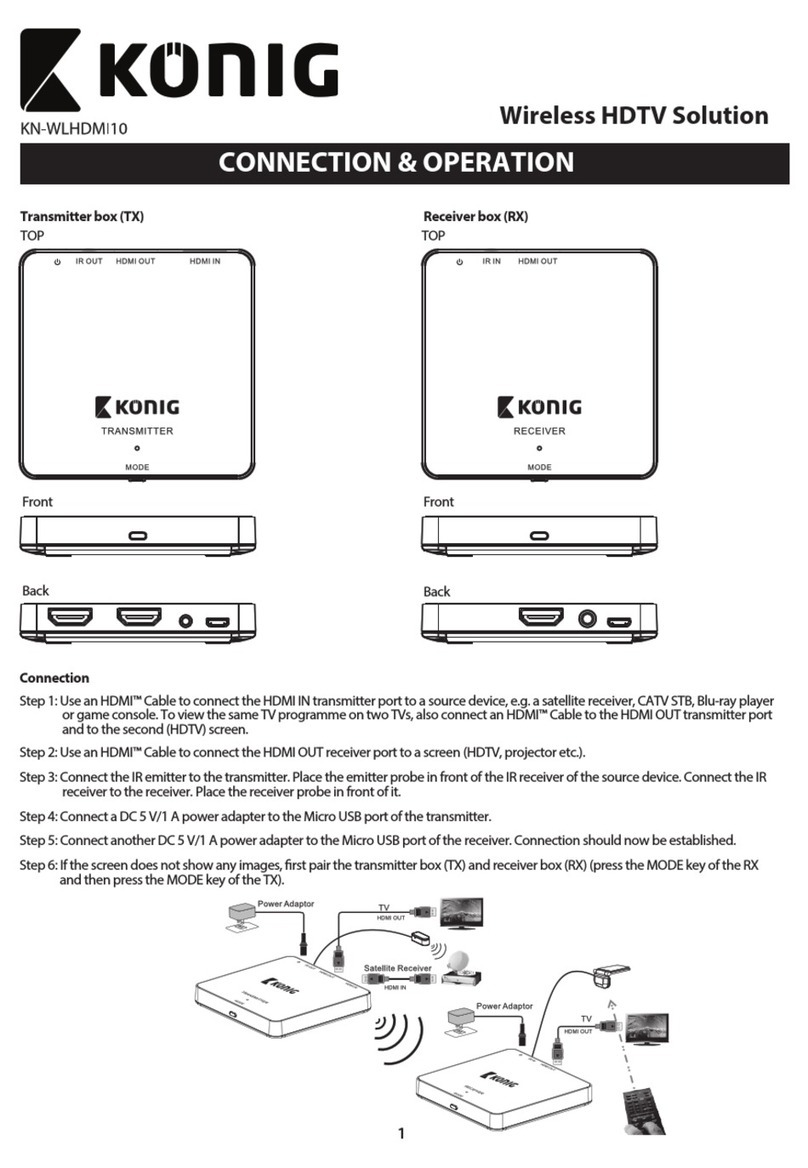
König
König KN-WLHDMI10 Connection & operation
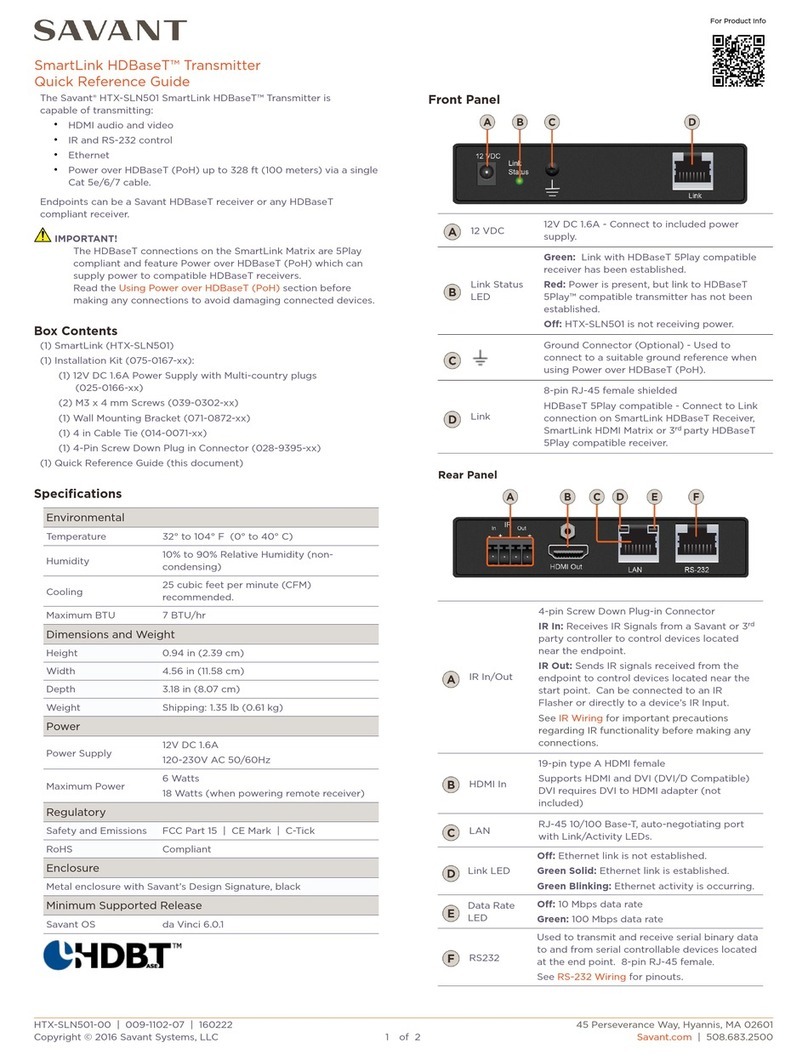
Savant
Savant SmartLink HDBaseT HTX-SLN501 Quick reference guide
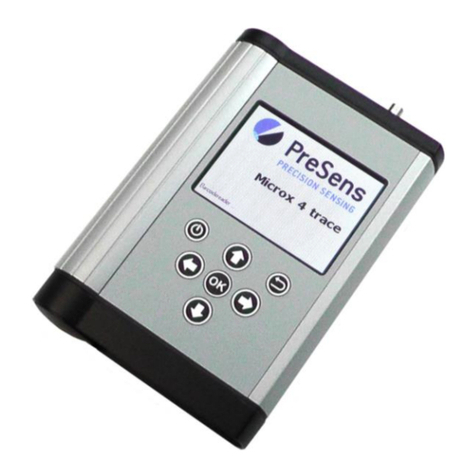
PreSens
PreSens Microx 4 instruction manual
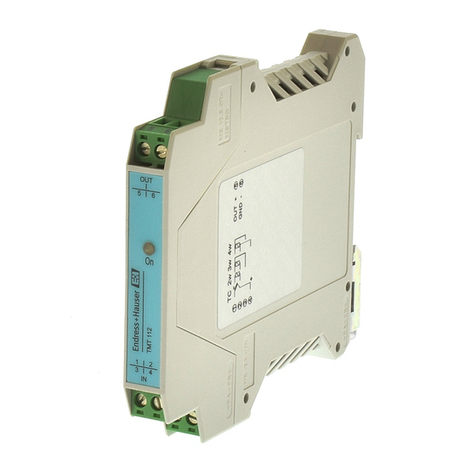
Endress+Hauser
Endress+Hauser iTEMP TMT112 operating instructions
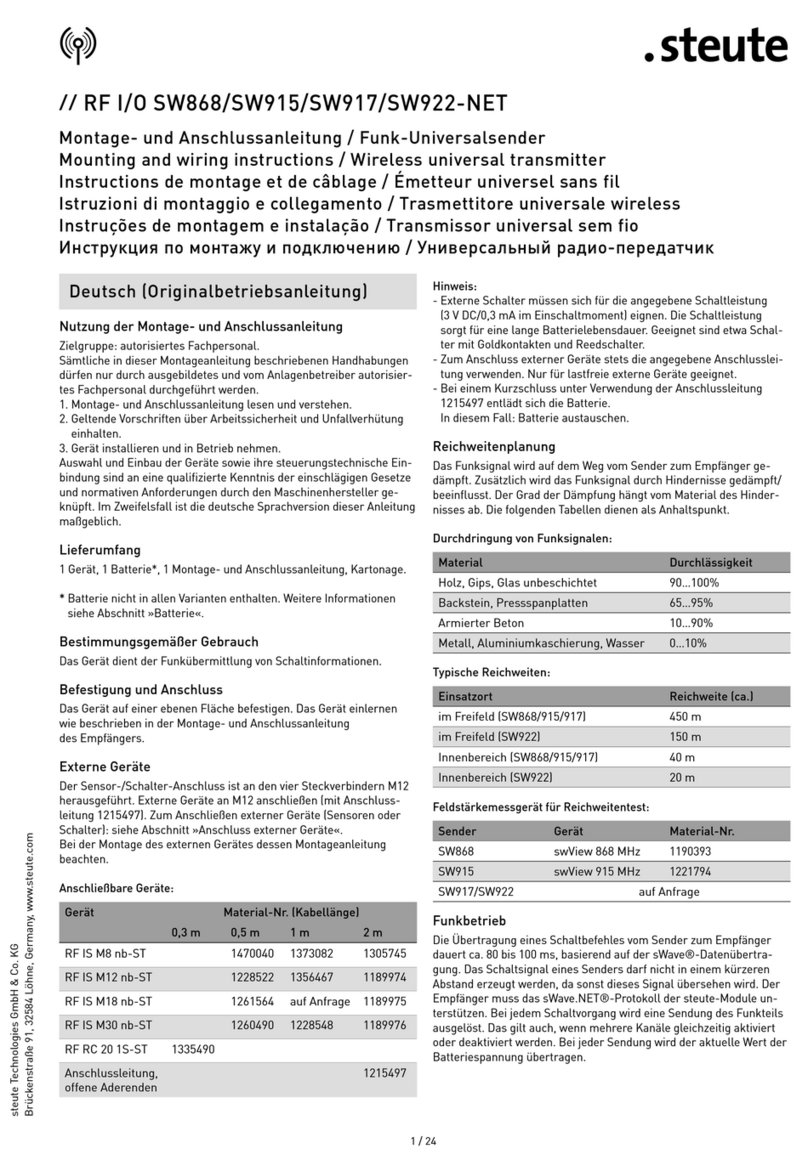
steute
steute RF I/O SW868-NET Mounting and wiring instructions

